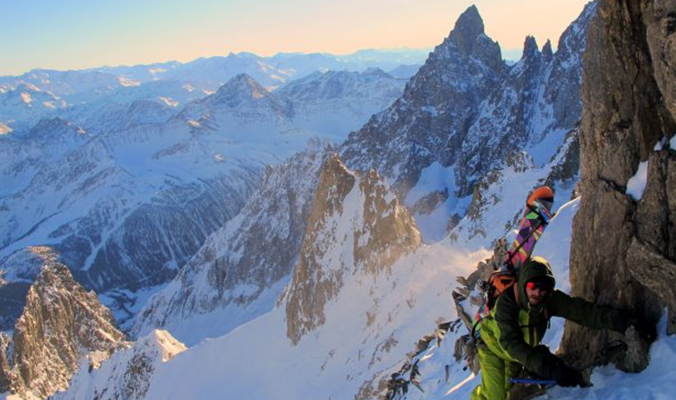Now, back in Chamonix and taking full advantage of the skiing and photography found there, Bernardini hopes to quit his day job at a hotel in the next few years and become a full-time photographer. When Backcountry got him on the phone, Bernardini talked about days off, being lazy and skiing with friends.
Backcountry: How did you get into photography?
Cedric Bernardini: It’s always been a hobby, but I bought a proper camera only three years ago just because those little point-and-shoots were very frustrating. I always thought [skiing] was very photogenic. That was a good way for me to tell [people] what I was doing, whether I was in Mammoth or here in Chamonix. It was always a good way to share what I’m out doing everyday, with all kinds of people. So, professionally, it has been just three years. I had started to hang out with a lot of people that were sponsored and pro riders and stuff like that, and that’s how I got to the whole professional side of everything.
BCM: What goes into making a great shot?
CB: That depends what you call a great shot. A shot that is meaningful for me is different than a shot that would be a great shot for magazines or a great shot for some website. It’s the difference of who’s going to look at that shot. For me, a lot of that [comes from] the story behind the shot or if I went somewhere and I’m able to take something that is spontaneous and something that tells the story of where I was and what I was doing.
But for a magazine you have to just go out when there’s perfect light and have a perfect skier and a perfect scene, and then you can work that all together for a few hours in the same place. Whenever I ski it’s really a day off, so I like to enjoy it.
BCM: What’s your biggest weakness?CB: My biggest weakness in the outdoor thing is that I’m pretty lazy. I don’t go after performance. It’s hard for me to train in the fall or even in the summer. I am still doing a little bit, but it is a little hard.
BCM: What are some defining moments or high points in your career?
CB: [Being a part of the first snowboard descent on] Monviso’s Coolidge Couloir would be my best moment. That’s pretty much how I started to be a more professional photographer, because I made a beautiful picture of a snowboarder and it was a first snowboard descent. That’s how everything got publicized, and we were stoked. But it was a really good summit in Italy and a beautiful descent.
BCM: Where does your inspiration come from?
CB: The people I go [skiing] with a lot of the time. When it’s a good group of people and there’s a lot of good energy between the group, I feel compelled to take a lot of pictures. When we go on two- or three-day trips, the beauty of the place where we’re going and how remote and special and original it is [inspires]. But it’s definitely about the people around me.


![Bernardini skis Vallée Blanche powder. [Photo] Minna Riihimaki](http://backcountrymagazine.com/wp-content/uploads/2014/09/valleyblanche.jpg)









Related posts:
Snow Shooter: Yves Garneau
Snow Shooter: Ian Coble
Snow Shooter: Mattias Fredriksson
Snow Shooter: Louis Arevalo